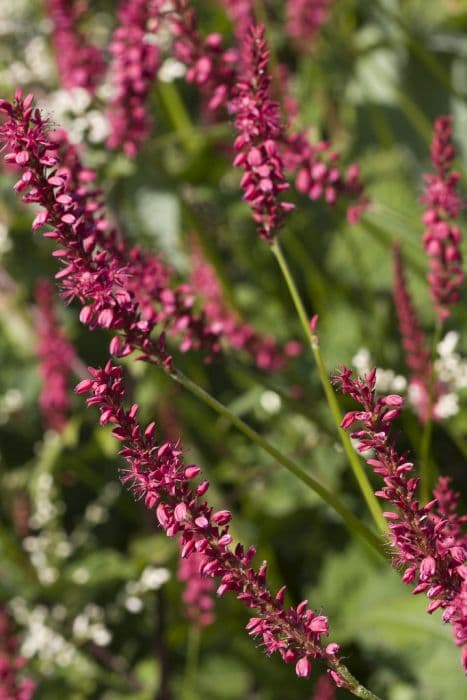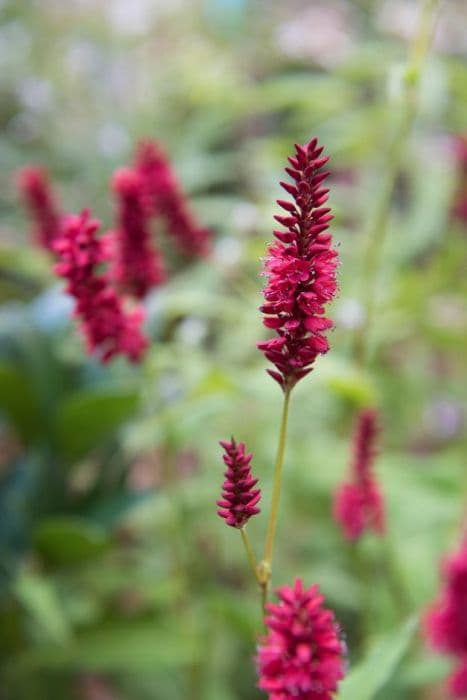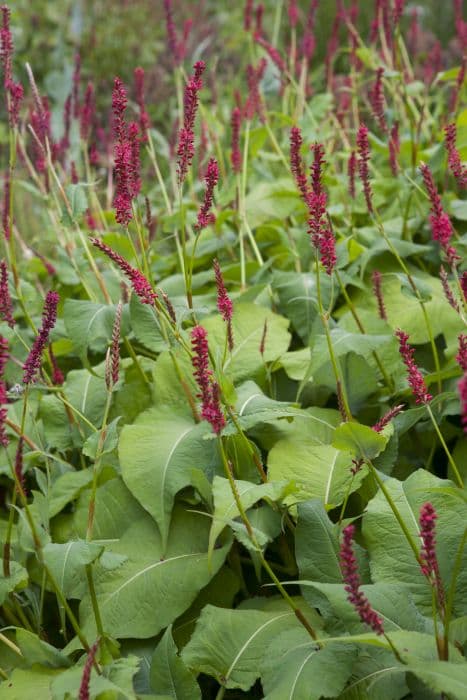Bistort Persicaria bistorta

ABOUT
Persicaria bistorta, commonly known as bistort or snake root, is a perennial herb with a distinctive appearance that includes a dense spike of pink flowers. The flowers are small, numerous, and form a bottlebrush-like inflorescence at the top of a leafless stem. These blooms boast a rosy-pink hue and are tightly clustered together, making the flower spike quite prominent. The leaves of bistort are broadly oval with a pointed tip and tend to be somewhat undulated or slightly wavy along the edges. Each leaf boasts a striking pleated or ribbed texture. The leaves are a vibrant green color, providing a lush backdrop for the flowers when they are in bloom. Bistort's foliage forms a basal rosette at the base of the plant. This low-growing clump of leaves is typically the first part of the plant to emerge in the spring. From this base, the flowering stems rise, bearing the attractive spikes that draw the eye and serve as the plant's most defining feature. The root system of bistort is characterized by a thick, twisted rhizome, which is how it gets one of its common names, snake root. This rhizome is traditionally known for its historical medicinal uses.
About this plant
 Names
NamesFamily
Polygonaceae.
Synonyms
Bistort, Snakeweed, Easter-ledges, Adderwort, Dragonwort, Twice-wrapped, Osterick, Easter Giant.
Common names
Bistorta major, Bistorta officinalis, Persicaria bistorta, Polygonum bistorta, Polygonum bistortoides.
 Toxicity
ToxicityTo humans
Bistort is generally considered non-toxic to humans and is even used in some culinary traditions. There are no well-documented cases of toxicity or poisoning from ingesting normal quantities of Bistort. Eating large amounts of any plant could potentially cause stomach discomfort or other digestive issues, but Bistort does not contain known toxic compounds that would cause specific symptoms of poisoning.
To pets
Bistort is also generally considered non-toxic to pets such as dogs and cats. It does not contain compounds known to be harmful to animals when ingested in typical amounts that could occur during accidental consumption. As with any non-food plant material, ingestion could potentially lead to mild gastrointestinal upset, but there are no specific toxic effects expected from Bistort for pets.
 Characteristics
CharacteristicsLife cycle
Perennials
Foliage type
Deciduous
Color of leaves
Green
Flower color
Pink
Height
2 feet (60 cm)
Spread
2 feet (60 cm)
Plant type
Herb
Hardiness zones
4
Native area
Europe Asia
Benefits
 General Benefits
General Benefits- Attracts pollinators: Persicaria bistorta, commonly known as bistort, is known to attract bees and butterflies, which are essential for pollination.
- Aesthetic appeal: With its pink, bottlebrush-like flower spikes and lush green foliage, bistort adds beauty to gardens and landscapes.
- Low maintenance: Bistort is a hardy perennial that requires minimal care once established, making it ideal for gardeners of all levels.
- Tolerance of poor soils: It can thrive in a variety of soil conditions, including both wet and somewhat dry soils.
- Erosion control: The dense growth habit of bistort can help stabilize soil and prevent erosion on slopes and banks.
- Wildlife habitat: The plant can provide shelter and food for various small insects and birds.
- Culinary use: Though not commonly used today, the young leaves and shoots are edible and were traditionally consumed in some regions.
- Cultural significance: Bistort has a place in folklore and has been used in various cultural rituals and traditions.
 Medical Properties
Medical Properties- Anti-inflammatory: Persicaria bistorta has been traditionally used to reduce inflammation.
- Astringent: The plant has astringent properties, which help to constrict tissues and reduce secretions.
- Diuretic: It may promote the production of urine, helping in the flushing out of toxins from the body.
- Antiseptic: Persicaria bistorta is known to have antiseptic properties, which can inhibit the growth of microorganisms.
- Antipyretic: The plant has been used to reduce fever in traditional medicine.
- Gastrointestinal aid: It is believed to help with digestive issues, including diarrhea and dysentery.
- Hemostatic: Persicaria bistorta might be used to stop bleeding, both internally and externally.
- Oral health: It has been used to treat mouth sores and bleeding gums.
- Wound healing: The plant may be applied to wounds to promote healing.
 Air-purifying Qualities
Air-purifying QualitiesThis plant is not specifically known for air purifying qualities.
 Other Uses
Other Uses- Persicaria bistorta, also known as Bistort, has been historically used as a food source, particularly in the North of England, where its leaves were consumed as a part of a dish called "Easter ledger pudding".
- The roots of Bistort can be used as a natural dye, producing a variety of colors ranging from brown to pink, depending on the mordant used.
- In landscaping, due to its dense and clumping habit, Bistort can be utilized as a groundcover that can help prevent soil erosion on slopes or riverbanks.
- The flower spikes of Bistort can be dried and used in floral arrangements, adding a rustic charm to autumn or winter displays.
- Gardeners sometimes plant Bistort to attract pollinators like bees and butterflies due to its elongated inflorescences and rich nectar.
- In rural traditions, Bistort was sometimes included in garlands and wreaths as a symbol of serpentine wisdom and healing due to its snakelike, twisted roots.
- The plant's extensive root system has been utilized to stabilize loose substrates in reclaimed mining sites and other degraded lands.
- Bistort can be cultivated as companion plants in gardens, as they are believed to deter certain types of pests from more vulnerable crops.
- Farmers in certain regions use Bistort as a natural indicator of soil fertility, observing where it thrives to determine the richer parts of their land.
- The leaves of Bistort can be used as a green manure or compost ingredient, enriching soil with nutrients as they decompose.
Interesting Facts
 Feng Shui
Feng ShuiThe Bistort is not used in Feng Shui practice.
 Zodiac Sign Compitability
Zodiac Sign CompitabilityThe Bistort is not used in astrology practice.
 Plant Symbolism
Plant Symbolism- Healing: Persicaria bistorta, commonly known as Bistort, has a history of being used for its medicinal properties, particularly in traditional remedies for treating wounds and inflammation. Therefore, it symbolizes healing and the alleviation of pain.
- Resilience: Bistort is a hardy plant that can thrive in a variety of conditions, often in less than ideal soils, which makes it a symbol of resilience and the ability to endure challenges.
- Connection to nature: Bistort, with its serpentine-shaped roots that are reminiscent of a snake, signifies a deep connection with the earth and natural cycles, representing groundedness and stability.
- Prosperity: The abundant growth and spread of Bistort can symbolize prosperity and fertility, as it covers the ground generously when it flourishes.
 Water
WaterThe Bistort should be watered deeply until the water starts to run out from the bottom of the pot, which typically means using approximately 1-2 gallons for a medium-sized garden specimen, every week during the growing season. Reduce frequency to every two to three weeks during the cooler months when the plant is not actively growing. Normally, the plant prefers consistently moist soil, so it's best to water it once the top inch of soil feels dry to the touch. Overwatering or allowing the plant to sit in soggy soil can lead to root rot, so ensure proper drainage is in place.
 Light
LightBistort thrives in full sun to partial shade. It will perform best when it gets at least four to six hours of sunlight per day. A spot with morning sun and afternoon shade is ideal, particularly in hotter climates, to prevent the leaves from scorching. However, in cooler climates, full sun throughout the day is beneficial for the health and flowering of the plant.
 Temperature
TemperatureBistort is hardy and can tolerate a range of temperatures, but the ideal temperatures are between 50°F and 70°F. It can survive minimum temperatures down to around -20°F and maximum temperatures as high as 85°F, although prolonged exposure to these extremes is not recommended. It's important to protect it from harsh winter winds and extremely high summer temperatures.
 Pruning
PruningPruning Bistort involves cutting back the spent flower stalks after blooming to promote a second flush of flowers and maintain the plant's attractive appearance. Prune also in late winter or early spring to remove any dead or damaged foliage. The best time for major pruning is in early spring, just before new growth appears.
 Cleaning
CleaningAs needed
 Soil
SoilBistort thrives best in moist, fertile soil with good drainage. The ideal pH range for Bistort is between 5.5 to 7.0. A soil mixture composed of loamy garden soil, peat or compost, and a bit of sand to facilitate drainage would be appropriate for this plant.
 Repotting
RepottingBistort does not require frequent repotting and can be done every 2-3 years. However, division of large clumps can be performed in early spring or after the flowering period to rejuvenate the plant and propagate it.
 Humidity & Misting
Humidity & MistingBistort prefers a moderate level of humidity but is quite adaptable and can tolerate the varying humidity levels commonly found in outdoor garden settings.
 Suitable locations
Suitable locationsIndoor
Place Bistort in bright, indirect light and ensure soil stays moist.
Outdoor
Plant Bistort in partial shade; keep soil evenly moist.
Hardiness zone
3-9 USDA
 Life cycle
Life cyclePersicaria bistorta, commonly known as Bistort, begins its life as a seed, which germinates in moist soil in late winter to early spring. Once germinated, the seedling emerges and develops into a rosette of leaves, establishing a root system. As the plant matures, it produces elongated leaves and a stout, unbranched stem that can reach up to 75 cm in height. In late spring to early summer, Bistort produces dense, spike-like flower clusters that are pink or white. After flowering, the plant sets seeds that are dispersed by wind or water. Bistort is a perennial herb, so it dies back to the root in winter and regrows from the same root system the following spring.
 Propogation
PropogationPropogation time
Spring-Early Summer
The most popular method of propagating Persicaria bistorta, commonly known as Bistort, is through division. This is typically done in early spring or fall. The process involves carefully digging up the mature plant, ensuring a substantial amount of root is included. The clump is then gently broken apart into smaller sections, each with roots and shoots of their own. These individual sections are immediately planted into moist soil, spaced about 12 to 15 inches (30 to 38 centimeters) apart, and watered thoroughly to encourage establishment. This method promotes rapid growth and helps maintain the health and vigor of the plant, as well as its aesthetic flower production.









